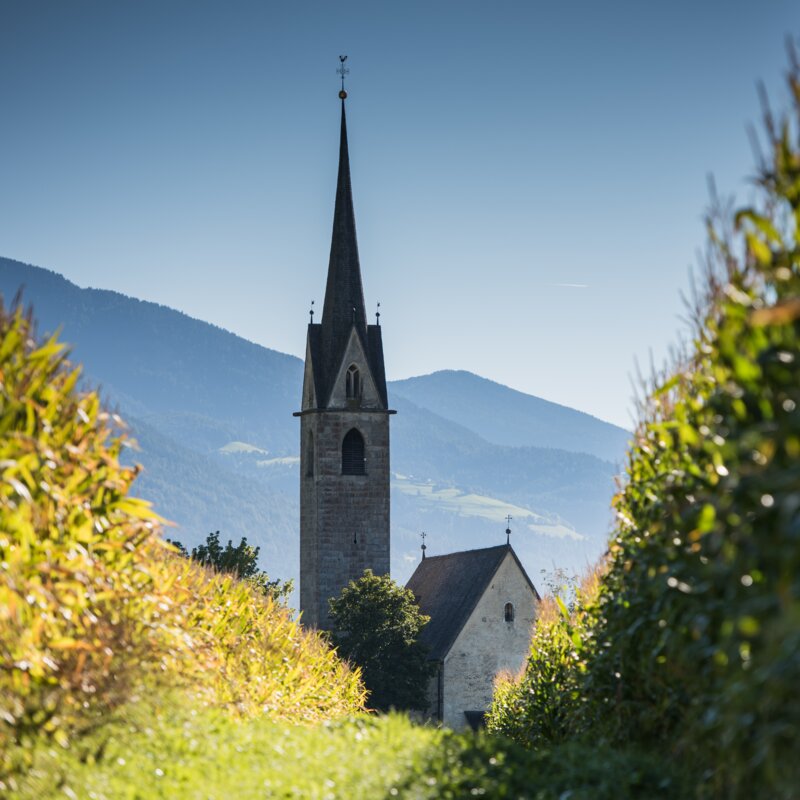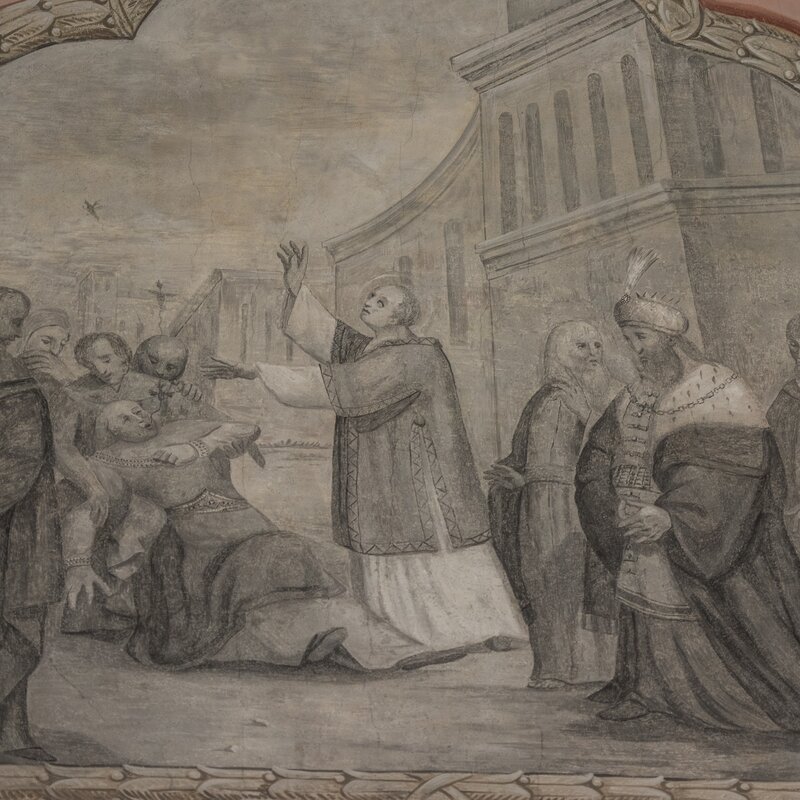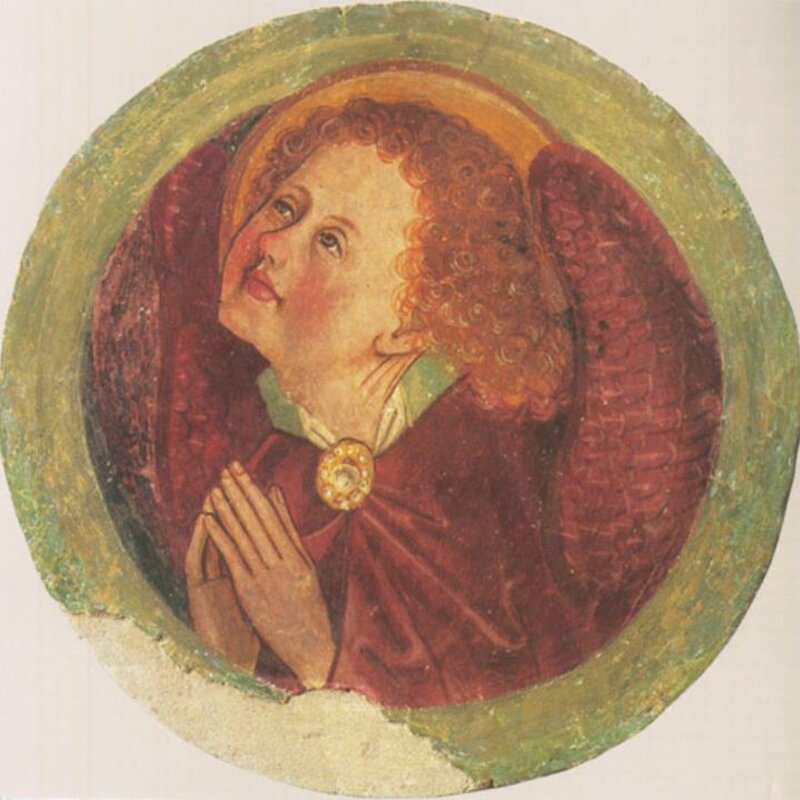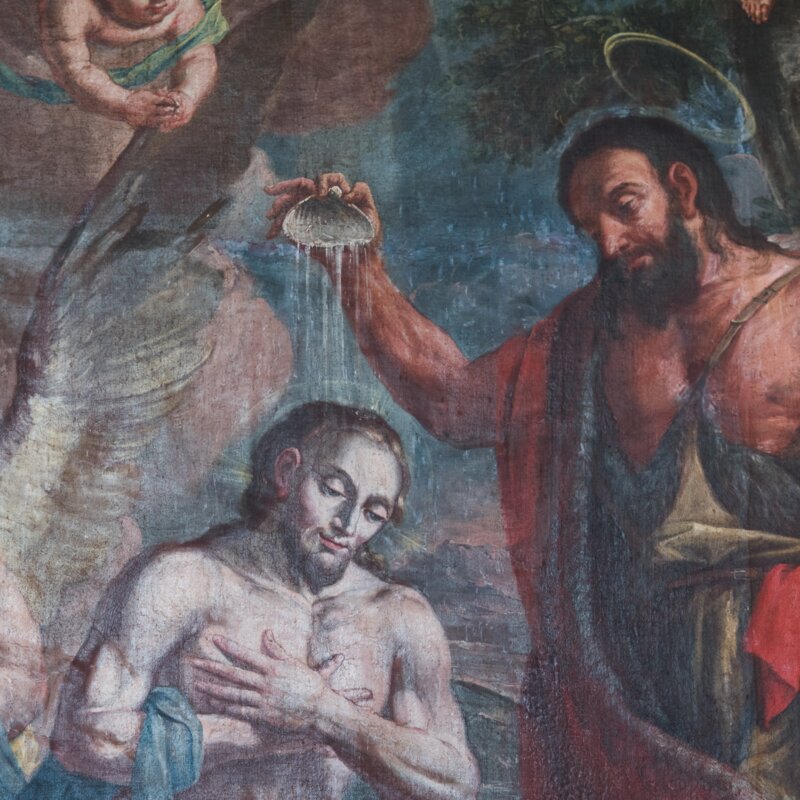City & Highlights



The pentagonal fresco framed with an ornamental border was donated in 1434 by Hans Mair im Feld and his wife Margareth.
In the central panel, the crucifixion of Christ is depicted in rich detail. At the foot of the cross kneels a miniature representation of the donor couple. On the left and on the right of Christ, tied to the cross with ropes, hang the "left" and the "right thief", whereby, alluding to the Gospel of Luke (Lk. 23:43), an angel saves the soul of the repentant sinner, while the soul of the "left thief" is taken by the devil. Beneath the cross are Mary, mother of Jesus, and John, the disciple Jesus loved.
In the left panel, the Visitation scene is set in one-point perspective architecture. Mary in light‑coloured clothing - analogous to the depiction beneath the cross - visits her cousin Elisabeth. The depiction of the two pregnant women is ichnographically interesting because the unborn children are visible on the mother's body: Jesus, surrounded with a halo, in an elevated position on Mary’s body, John in a kneeling position on Elisabeth’s body. During their greeting, the women's hands also enclose the unborn child of the cousin.
In the right panel, there follows a row of saints, depicted in a late Gothic palace. St Valentine of Raethia, recognisable by his attributes of green chasuble, mitre, crozier, and book, is turned away from the pair of doctors, Saints Cosmas and Damian, and apparently uninvolved in their conversation. Cosmas in the middle wears a green scarf over his cap, Damian on the right the apothecary's cap befitting his status. The erudition of the Syrian patrons of health is illustrated by a book.

The fresco cycle depicts the ten commandments, which is unique in Tyrolean iconography of the late Middle Ages. The sequence of the pictorial contents in the four bays of the nave reads from left to right. It is striking that in each case, it is the uppermost panel of the bay that is best preserved.
In the first bay, Moses (depicted as "Moses cornutus", as Moses with horns, as he is often found in iconography due to a translation error in Jerome's Vulgate) receives the stone tablets of the law from the hands of God on Mount Sinai. In the double panels below, the required observance of rest on feast days and the orderly way of life in marriage are illustrated both positively and negatively.
In the second bay, the worship of idols in the form of statues or celestial bodies is depicted as a counterstatement to the first commandment. The middle double panel contrasts the fourth commandment positively as caring for parents in vulnerable old age and negatively with the driving of the aged parents out of the house. The lower double panel represents the eighth commandment with true and false testimony.
The appropriate veneration of the divine name is illustrated in the pediment of the third bay: Inside a church, the priest raises the host, and a banner praises the Lord as Saviour of the world. The central panel refers to the fifth commandment and shows forgiveness and killing before the judge by means of two court scenes. In the lower double panel, two demurely dressed noble ladies are seated on the left under God's blessing hand; the scene on the right refers to the ninth commandment, which is a warning against the coveting of one's neighbour's wife.
In the fourth bay, the well-preserved pediment again refers to the second commandment. At a gambling table, the players resort to false oaths and curses, which in the view of the late Middle Ages was a violation of the second commandment. The middle double panel illustrates the seventh commandment. On the left, the hand of God rests over the honest craftsmen; on the right, thieves are shown using a ladder to break into a house at nightly hours under the guidance of a green devil, while the owners are asleep. The preserved remainders in the lower double panel suggest that the reference to owning a house may mean the tenth commandment.
In the two bays of the chancel, the story of Christ's Passion is divided across ten panels, some of which are incompletely preserved and others completely lost. In the first bay, the Olivet scene is clearly visible at the top, the flagellation below to the right, the crowning with thorns to the left with a larger missing section, the carrying of the cross below and opposite - difficult to discern - the scene of Jesus being nailed to the cross. On the panels of the second bay, the entombment is well preserved on the lower right, the Crucifixion can be made out on the left, the right middle double panel should probably be interpreted as the Ascension of Christ, the two remaining panels are completely lost.

The elaborately designed high altar with its emphasis on saints reflects the needs of a peasant population. The altarpiece by Franz Sebald Unterberger depicts St Valentine, the patron saint of livestock, blessing while floating on clouds. Another patron saint of livestock, Anthony Abbot, appears in the altar's excerpt image. As inner altar figures, the two livestock patrons Sylvester and Martin stand in mutual eye contact, the outer altar figures show the weather saints John and Paul. Art historians attribute the sculptures to Bruneck sculptor Johann Georg Silly.

The most valuable artifacts belonging to the church is a carved figure of St Valentine, which has been in the Diocesan Museum of Brixen since 1974. A replica from Gröden from 2009 can be seen in the church. For a long time, the original statue was interpreted as an early work by great local artist Michael Pacher; as such, the State Monuments Office also showed interest in it during the time of fascism and wanted to get hold of it.
The statue depicts St Valentine sitting on a throne, clothed in a golden chasuble, holding an open book in his right hand and the crosier in his left; on his head he wears a gold-studded mitre. Particularly striking are the episcopal rings visible above his gloves.
In art history, this statue of St Valentine is considered one of the great achievements of South Tyrolean sculpture before the time of Michael Pacher. In the style, characteristics and influences of the Leonhard workshop are still recognisable, the expression of the face already reminiscent of Pacher's masterly executions.

The church is dedicated to St Valentine. However, it remains unclear whether this patronage refers to Valentine of Terni, who, according to legend, was martyred on the Via Flaminia on 14 February 269 and became the patron saint of lovers; or whether Valentine refers to the Rhaetian saint who worked between Chur and Regensburg in the 5th century and died around 475 as a hermit in the castle Zenoburg near Meran. This Valentine of Raethia was a messenger of faith for a peasant population and is regarded as the patron for the thriving of people and livestock. As such, he is invoked against epidemic livestock diseases as well as against human ailments, especially gout, epilepsy, and cramps.
The aspects of both patron saints have remained alive in the St Valentine’s church in Greinwalden. The patronal festival is celebrated on 14 February, the anniversary of the death of the Roman martyr, in the form of a traditional Service of the local farming community with its special concerns. Beyond this 14th of February, however, the church with its strong symbolism is the preferred place for lovers when they tie the knot.

The high altar gives the impression of a cohesive and coherent overall composition in the chancel. It is therefore all the more surprising that it comes from the previous church and even there represented the result of different creative periods and artists' hands. The construction (executed by Johann Mussak), the altar leaf (by Karl Henrici) and the closer altar figures (saints Sebastian and Florian as well as several angels and a carved wooden dove in the centre of a halo of rays, symbolising the Holy Spirit, designed by the sculptor Andreas Sigmund from Feldthurns), date from the year of commission 1789. The portal figures of St Augustine and St Valentine by Johann Georg Silly are a generation older. The side angels by Georg Stieger sitting on the edges date back a further century. (During the last general renovation in 2018, these angels were moved to the altar excerpt).
Also valuable is the altarpiece by Karl Henrici, a Silesian artist who had been resident in Bozen since 1757 and was considered the most sought-after painter in the area. His works can be found in the monastery Stift Neustift, in the parish church of Taufers in Pustertal, in St. Kassian in Gadertal or in the church on Taisten, among others.
The altarpiece on the high altar shows the beheading of St Cyriac, who suffers martyrdom at the hands of a Roman centurion. Connoisseurs of art will also discover compositional elements of this painting in other works by Henrici.

The structure and sculptural decoration of the side altars date from the time of the building of the new church, as does the pulpit.
Since the renovation in 2018, the altar on the Gospel side has again been using the altarpiece with the depiction of the Coronation of Mary, made by Cosroe Dusi in 1836 for a previous altar. What is striking here is the twofold dimensioning of the scenery depicted: at the lower edge of the picture, the miniature earthly dimension of the apostles, who have gathered in front of Mary's empty tomb and are looking towards heaven; in the centre of the picture, the heavenly dimension of Mary's coronation in the presence of a choir of angels and the risen Christ with numerous elements of the Ecclesia triumphans.
The side figures, like the central sculptures of the high altar, are the work of the sculptor Andreas Sigmund from Feldthurns and represent Mary's parents: on the left St Joachim with little Mary in his arms and on the right St Anne. Sigmund's hand also created the four angels, which, in the excerpt, can be seen surrounding the halo of rays containing an emblem of Mary.
The right side altar is dedicated to St Joseph and uses as its altarpiece a depiction of the Holy Family, which includes little John under the protective mantle of the Mother of God. As an adult, he later appears at the River Jordan as John the Baptist. This altarpiece is attributed to painter Christian Holzinger, who is responsible for the entire fresco decoration of the church.
The sculptures on the altar depict the parents of John the Baptist: on the left the temple servant Zachariah, on the right Mary’s cousin Elisabeth with little John. The creator of the sculptural decoration is probably also Andreas Sigmund from Feldthurns.

In 1852, the church was painted by Carinthian artist Christian Holzinger. Many aspects of motif and design were clearly borrowed from classicist painter Josef Schöpf from Telfs. Josef Schöpf had created a similar fresco design for the parish church of Bruneck, which was however, completely destroyed in a fire in 1850.
The transfer of these designs to the new parish church of Pfalzen can be traced back to an initiative by parish priest Leopold Kofler, who received two sketches designed by Josef Schöpf handed from the monastery of Stams and used their ideas for the design of the ceiling frescoes in Pfalzen, which were then created on the new church ceiling by Christian Holzinger.
The central fresco in the nave depicts the Assumption of Mary. Grouped around Mary's empty sarcophagus are the eleven apostles, faced towards a celestial scene, in the centre of which Mary floats in a blue cloak up towards the risen Christ. Particularly pleasing are the dynamics of the spiral‑shaped figure composition, starting from the kneeling apostle on the left, via the centrally hovering Mary to the waiting Son of God and the implied hand of God in the right upper field. At the same time, the ring-shaped composition of the heavenly sphere around the central figure of Mary is a nimble contrast to the grounded grouping of the apostles around the empty sarcophagus.
The oval ceiling painting in the chancel are based on a similar composition technique. The central position of the monstrance shows the glorification of the Eucharistic host, whereby the earthly grouping with representatives of the four continents again corresponds with the heavenly grouping of angels and powers. The gradation of brightness from the shining halo of rays in the centre to the greens, reds, blues, and greys at the edges of the painting emphasises the message of Christ's Eucharistic presence that extends to the boundaries of earth.

The large crucifix on the east wall of the nave dates back to the previous church and most likely served as a pew crucifix there.
Beneath the crucifix is an extremely well-crafted Baroque pietà by a local artist of unknown name. For a long time, this Baroque sculpture was the central figure on the left side altar.
The Stations of the Cross also date back to the previous church and were created in 1819 by painter Josef Renzler.
The baptism font from 1578 was also part of the furnishings of the previous church.

The patrocinium of St Cyriac, which is rare in this country, dates back to the Middle Ages and allows us to speculate on a very early period of Roman influence connected to the original parish of St. Lorenzen.
At the rededication Service on 13 July 1854, following recommendations, the church was also dedicated to Holy Family. This is probably connected with the Brotherhood of Jesus, Mary and Joseph that was founded in 1700 and was widespread at that time.
The Roman deacon Cyriacus is mentioned several times in the records of martyrs. He belongs to those blood witnesses of Christ who, at the time of Emperor Diocletian, paid for their confession of faith with death. He was Deacon in Rome under Pope Marcellinus, and a supporter of the old, the poor and the needy and, according to legend, took part in the construction of Diocletian's thermal baths as a forced labourer. Legend also tells that Cyriacus, at the request of the emperor, freed his daughter Arthemia from an evil spirit. The depiction of this scene can be found on the east side of the ceiling painting in the parish church.
As a miracle healer, Cyriacus is also associated with the Persian king Sapor, whose daughter Jobia was freed from a demon with his help. The legend goes on to say that after his return from Persia, the saint was richly rewarded by Diocletian and given a house for him and his Christian companions to live in. But when Diocletian was out of the country, his co-regent Maximian had Cyriacus and his companions arrested, doused with hot oil, and eventually beheaded.
As a saint, Cyriacus is counted among the Fourteen Helpers in Need. He is invoked against frost and harmful weather, for help in resisting temptation by evil spirits and above all as support during hard physical work. In this latter aspect and in his role as a forced labourer in the construction of Diocletian's thermal baths that there is a possible connection to the ancient and strenuous activity of the stonemasons of Pfalzen and to their sweaty work in the granite quarries of the town. One can imagine that the patron saint for the church was chosen for this reason.

One of the distinctive features of St Nicholas Church is an old clockwork that in earlier times, controlled the hands of the church tower clock. This skilfully crafted mechanism from 1548 is exhibited in restored and partially reconstructed form inside the church.
During cleaning work in the autumn of 2019, firefighters from the Issing volunteer fire brigade came across the meagre remains of the old tower clock, which had probably been stored here since the 1960s, in a depot room behind the pulpit: The pendulum, crank, weights and even some gears were missing.
It is thanks to the expert knowledge and skill of Johann Oberjakober, a trained blacksmith and current farmer at the Niederhäuser farm, that these relics of the old tower clock were not simply disposed of, but were artfully maintained, cleaned, supplemented, and reassembled to their original functional capability.
During months of voluntary work, Johann Oberjakober, who is himself a passionate connoisseur and collector of old clocks and who visited and studied the most valuable pieces from the world‑famous clock museum in the Torre di S. Andrea in Chioggia, restored the functionality of the old tower clock of the church of Issing.

Closely connected with St Nicholas’ church in Issing is the early work of the famous late Gothic painter and carver Michael Pacher. The invoice to "maister Michel maler" from 1459 (kept in the parish archives of Pfalzen) for the painting of the keystones above the Gothic ribbed vault is the oldest document proof for Michael Pacher's artistic activity and at the same time an orientation aid in the reconstruction of the artist's early biography. Because there is only conjecture as to Pacher's place and year of birth, it is precisely these early works on the church in Issing that are seen as a supporting argument for the thesis that "maister Michel" could very well have come from the Pacher house in Mühlen near Issing. After having been apprenticed to Master Leonhard in Brixen and now in his mid-twenties, he could have carried out this painting work close to where he was born.
The works of Michael Pacher, master of late Gothic altarpiece design, include the St Laurentius altar in St. Lorenzen, the Marian Altar in Gries parish church, the Church Fathers Altar in Neustift, the winged altarpiece in St Wolfgang am Wolfgangsee and the large choir altar in the Franciscan Church in Salzburg. Of all these works, only the winged altar of St Wolfgang has been completely preserved in its location.

The church of Hasenried is located in the immediate vicinity of an ancient healing spring and probably owes its existence to this. This spring is the reason for the dedication of the church to John the Baptist, who baptised people with the water of the Jordan. Even if the chronology shows that St John’s church (1346) was much older than the well chapel (1716), the spring was certainly the destination of many people seeking relief for eye ailments, gout, and paralysis long before the church was built.
For centuries, the streams of pilgrims to this holy spring brought in large donations to the daughter church of Hasenried. The importance of these donations can be seen, for example, in the fact that when the parish of Pfalzen was separated from the original parish of Kiens, the parish priest of Kiens did not want to be without the moneys from Hasenried; it is also significant that when the parish church of Pfalzen was rebuilt in 1851, a considerable part of the building costs was financed from the surpluses of the daughter church of Hasenried.